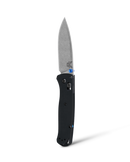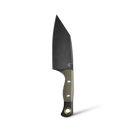Chances are, if you've ever been camping, you have spent time around a campfire. Whether chatting with friends, sharing stories from the good old days, or just recapping the day’s adventures, there is something uniquely special and timeless about campfires and the atmosphere they create.
Something else I've noticed about sharing campfires with friends is there's almost always a designated "fire starter" in the group—someone who takes pleasure in crafting and assembling the perfect inferno. Each has their own methods, processes, tips, and tricks, all working to varying degrees of success. There is the cardboard box person, the propane torch person, and the "bushcrafter" person who starts the fire with a spark and some lint from their pocket.
That last one I mentioned is me. And in this post, I’ll share my personal favorite method for building and starting a campfire.

The Fire Building Process
It’s worth noting that all the methods mentioned above are valid ways to start a fire, and if the result is a roaring hot blaze to warm hands and hearts, then you are good to go.
That said, the method outlined below will add to the campfire experience in a way that's hard to describe. Besides being a potentially lifesaving skill, starting a fire with a spark requires patience, focus, and preparation—all of which will immerse you in the moment to make your adventure much more special.
Think of building a fire like building a ladder for your flames to climb. When starting a fire with a spark, you are beginning at the very bottom of the ladder, and if you are missing a rung, the fire will struggle to grow and might die out.
You've likely heard the phrase "location, location, location" when referring to real estate. With fire-starting, I like to say that "preparation, preparation, preparation" is the key. Here are the steps to follow:
Step 1: Gather your wood.
In most cases, you will likely have brought a bundle of firewood with you, but bonus points are awarded if you forage for the ingredients of your blaze. In this photo series, for the sake of simplicity, I'm using a single piece of firewood from a store-bought bundle and breaking it down into everything you will need.
Step 2: Organize your parts.
I like to lay everything out according to size so it’s easy to see what I need, and where I might be missing a rung from my ladder.
Step: 3 Create the kindling.
Kindling is the magic that will get your fire up and roaring. It includes the smallest pieces up to the finger-sized sections of wood. To make these pieces from a larger log, place a fixed blade knife on the log and position it to cut with the grain. Use a sturdy stick to drive the knife blade through the log, splitting it into smaller pieces to help build the perfect ladder for your fire to climb. This process is often called "batoning."
Step 4: Make a feather stick.
A feather stick is made of the super-thin wood shavings that the spark will take to, and making it is time-consuming but fun. The goal is to carve thin slices into the wood that curl up in neat succession. Besides looking beautiful, the curl of the shavings is the key component to the fire starting, as they create a natural loft in your kindling for airflow and allow maximum surface area for the flame to consume.
If you planned for this fire, you might have some dryer lint, cotton balls, or something similar to help your spark catch. If not, you’ll need to be much more thorough with this step of the process.
Step 5: Build the base and prep for flames.
I like to create a little structure to hold my feather stick; this gives you something to build the fire around, while also blocking the wind from blowing out the flames.
As the last step before striking the spark, I like to lay out all the prepped wood in arm’s reach so I can quickly build the fire as the flames take to the shavings.
Step 6: Spark and enjoy!
Light it up and get ready to sit back and enjoy your creation, along with the newly-earned admiration of your camp buddies.
For more overland and adventure content, follow Micah Weber of Overland Under Budget on Instagram.





5 comments
Looks like you used the knife blade to create a spark? Don’t you also need a flint of some sort? And some technique to capture the spark into the lint.
Previously I left a very good post on this site about starting a campfire. There was no profanity, malice, bad language. However, now when I am checking to see if there was any followup, my post is nowhere to be found. Why was it suppressed?
First, I am not getting the pictures that go with this story. I really wanted to see them as fire starting is a specialty of mine. Is there any thing I can do to get these pictures?
Next, the process of making kindling or smaller pieces of wood from a larger log or piece of a log is properly known as “Batoning”. The way it is spelled in the post is more like “Button-ing” or like a button. No, what we want is a small piece of wood similar to a orchestra conductors baton or a Majorette’s twirling baton. Might be French in origin.
Anyway, if the woods have not had rain in a few days you may be able to forage small dry sticks and eliminate the need for batoning. If the twig is off of the ground and snaps crisp and clean it is good to use.
Great advice….Thank you!
Saw this post on LinkedIn, I have two young ones I am teaching them about hunting and exploring. This will be my next knife! Great story, and thank you for sharing.